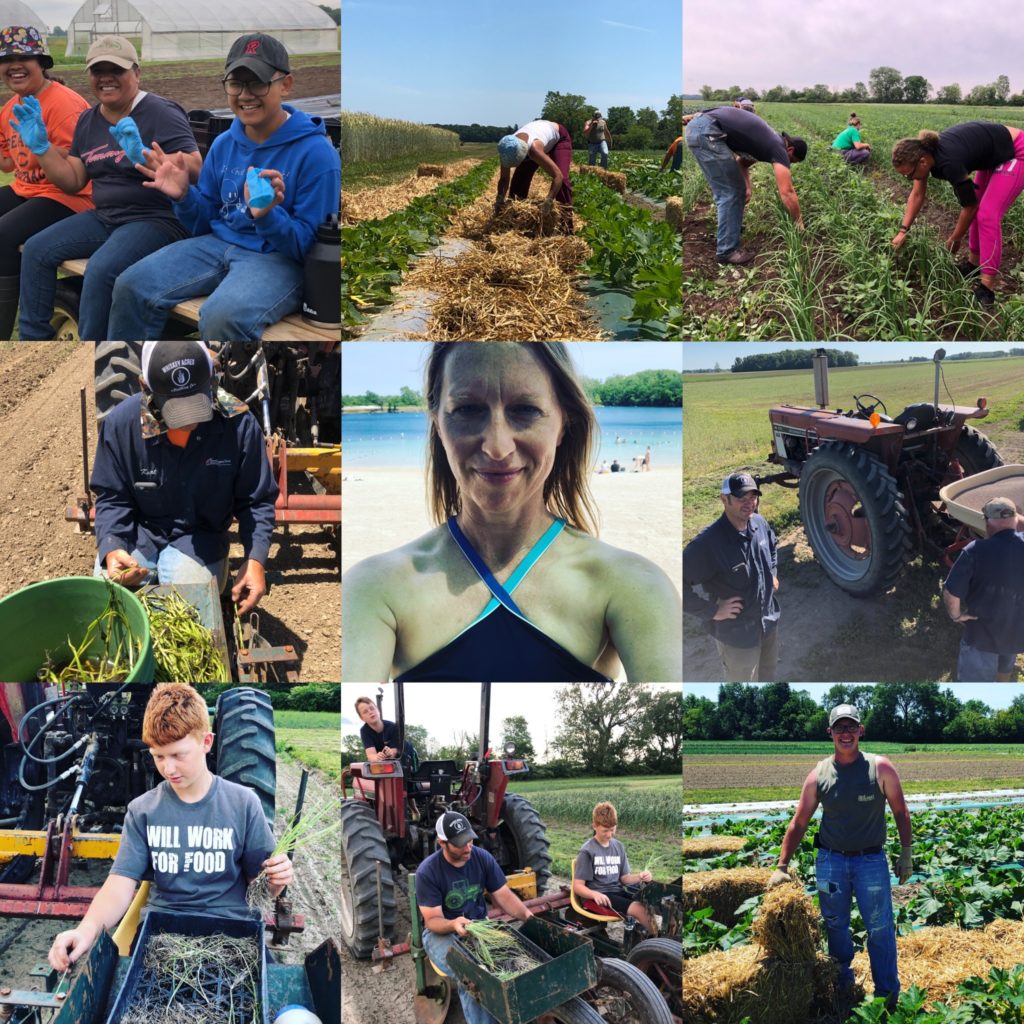CSA Newsletter Week 3 (June 20-26,2021)
CSA Newsletter Week 3
June 20-26, 2021 | “A” Week
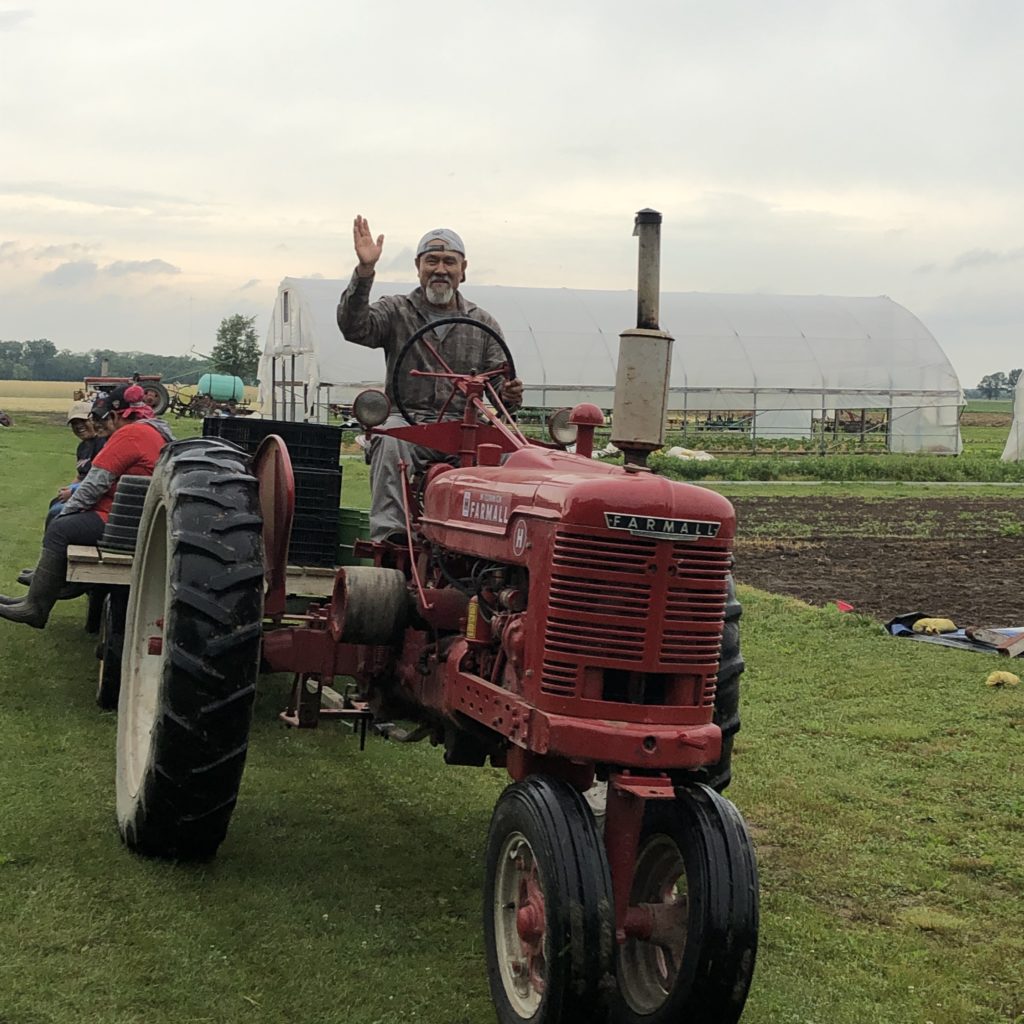
Isaiah is SO excited! His first time driving a tractor.
What’s in the Box this Week?
GARLIC SCAPES ~ These June delicacies will be in your box for the last time this week. They have a curlicue shape, and a garlic flavor. Chop off the bottom inch of the scape (the tough end), and discard. You can eat the scapes roasted on the grill whole; try them in a pesto. Or you can chop/mince the scape (even the flower bulb part), and use it wherever you would garlic. Store the scapes whole or chopped in a Ziploc baggie, and use within a couple weeks. If you can’t get through it fast enough, just throw them into the freezer.
HEAD LETTUCE ~ I know you’re overloaded with lettuce from us. But we have more, and we need to use it before it goes bitter! So we’re sharing it! Store this in a Debbie Meyer Green bag or Tupperware FridgeSmart container right away and leave it in the fridge. I wouldn’t wash this until you’re ready to use it. Use within a couple weeks. You should get either a red or a green variety.
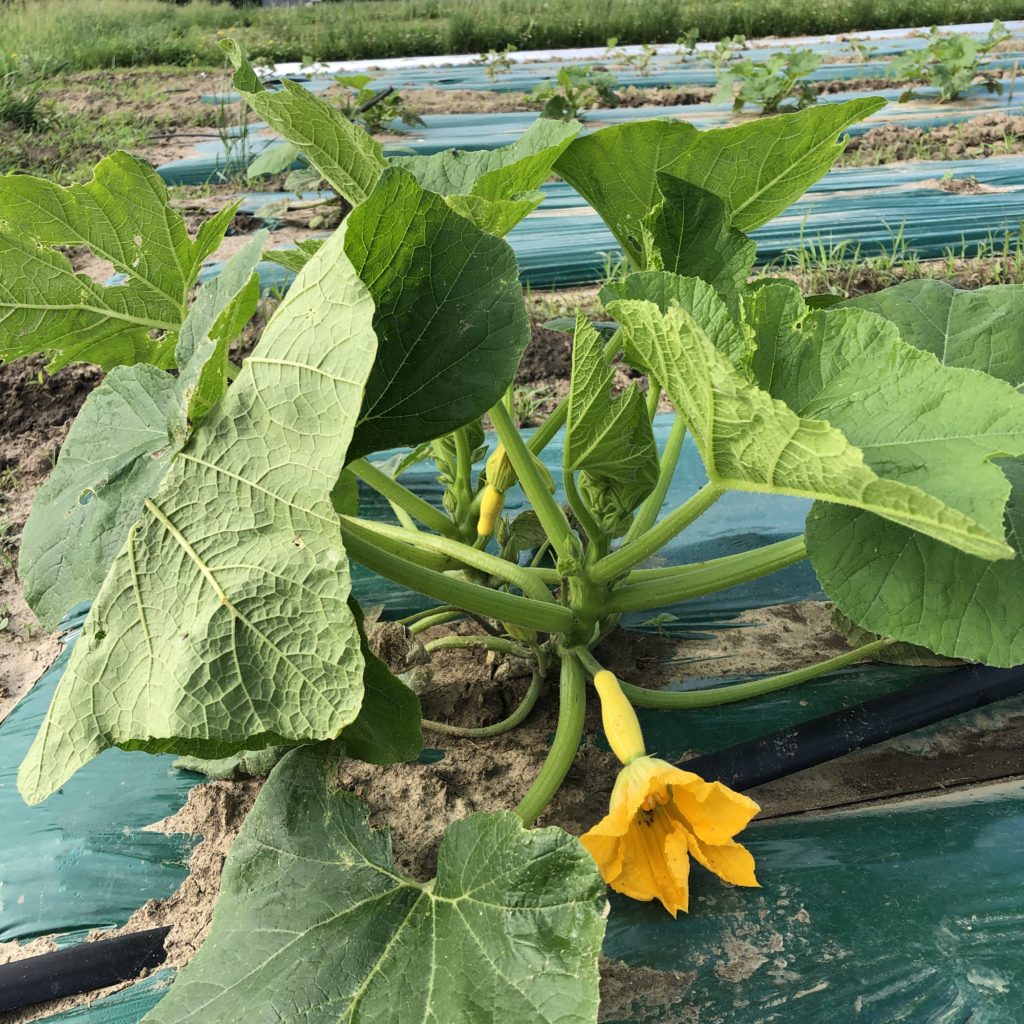
See the yellow squash forming on the end of the flower?!
ZUCCHINI & YELLOW SQUASH ~ These summer squashes will come from our farm, as well as a member of our CSA farm cooperative, Mile Creek Farm near Columbus. Zucchini will only last about 3-5 days. Store it in a plastic bag or a Fridgesmart container. I like to grill these in long strips with some olive oil. They’re also great spiralized as noodles. Or try grating the zucchini and baking with it.
KALE ~ Store these in a Debbie Meyer green bag and use within 10 days. Remove the leaves from the tough stems. You can use the stems for stir fries. The leaves can be made into kale chips, blanched and used in dips or sauces or simply sauteed with a vinegar dressing. If this veggie intimidates you, try making our CSA’s popular frozen “Green Cubes” and add them to stews/sauces for later. (This is what we do at the farm).
WHITE SCALLIONS ~ Place your scallions into a glass filled with an inch of cold water and place it in your fridge (or leave on the counter). I like to place a baggie over the tops of the greens, if it’s going in my fridge to keep them from drying out. Refresh the water every 3 days. These will last a long time stored this way. You can trim the green tops of the scallion and use them to garnish tacos or salads or meat dishes. You can also chop them up and freeze them for later use! The white tips of the onions are often used in salad dressing vinaigrettes, on salads, or enjoyed grilled with a little olive oil and s/p.
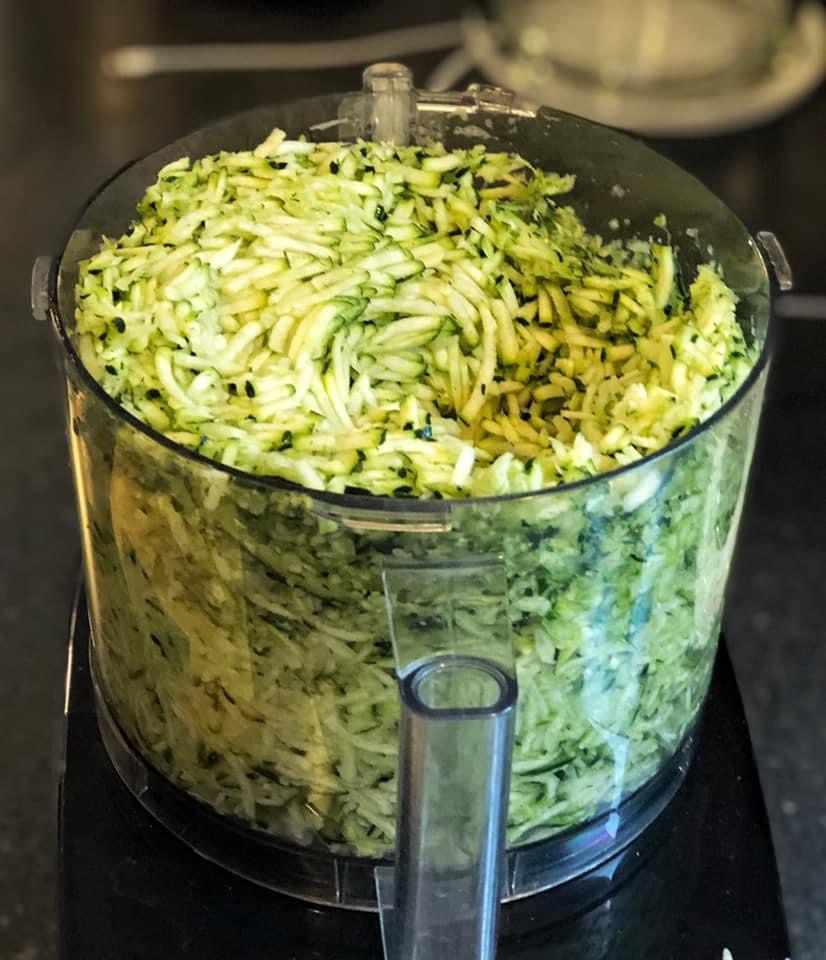
Did you know you can freeze shredded or diced zucchini?
GREEN KOHLRABI — This medium-sized head of kohlrabi is a member of the broccoli/cabbage family. It forms as a bulb on top of the soil bed. The leaves are totally edible — use them like you would kale. The bulb has a thick skin around it. You’ll need to peel that off (or use a knife). The inside is a crisp texture like a radish, but not spicy. I like to eat it raw, diced, in a veggie platter with some dip. You can also steam it and then mash it with some potatoes. It’s also great grilled or roasted with other veggies. And you can grate it raw and add it to a cole slaw with some cabbage.
POTTED HERB PLANT ~ Every year, we give our CSA members two different potted herb plants. You will be given a choice at pickup of several herb types. When you take it home, put it in a sunny place in your garden or on your kitchen windowsill. Then be sure to “prune” the plant as it grows. This means cutting the herb leaves along the stem. This will cause the plant to branch off where you pruned it, and get bushier over time. It’s important to stimulate growth by pruning!
THIS WEEK’S ADD-ON SHARES:
It’s “A” week again (for all our bi-weekly shares)
Knueven Ice Cream Club: Cold Brew coffee!! (my fave)
Fruit: 1/2 pint of red currants (a first for us) – these come from Wayward Seed Farm in Fremont, certified organic; 1 quart of strawberries from Polter’s Berries in Fremont (not organic); 1.5# pouch of sweet red cherries from Quarry Hill Orchard in Berlin Heights (not organic)
Maddie & Bella’s Coffee: Brazil Bob-o-Link – Rich aroma of maple, hints of fruit and lots of sweetness; full body tin the cup with notes of maple and blueberries with a long sweet aftertaste and mild acidity.
Cheese Share: Wabash Erie Canal (Gruyers), Charloe (award-winning), garlic and dill goat cheese curds
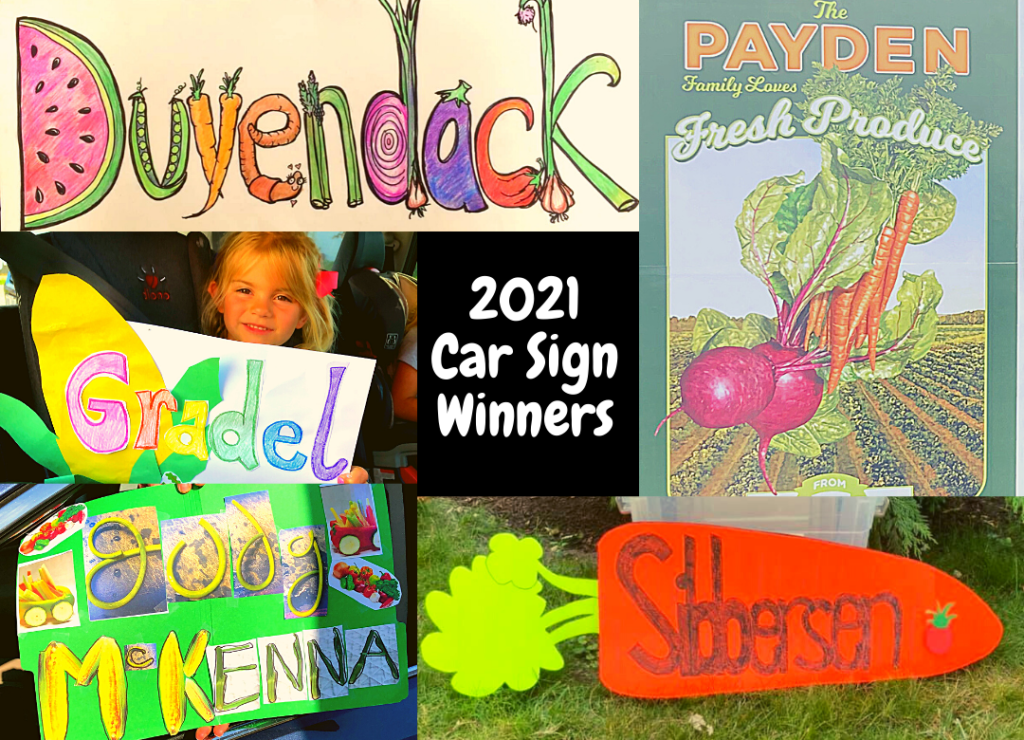
The winners of this year’s Car Sign Contest!
Winners of our Car Sign Contest
There were SO many fun entries this year to the contest. We chose one winner per site this time — except for Perrysburg, where we had two co-winners. And we chose them based on an unofficial “gut feeling” of what we liked the most. We considered artistic ability & effort, creativity, enthusiasm and fun, cleverness, and branding appeal. Here they are:
- Port Clinton: Judy McKenna
- Elmore: Gradel Family
- Perrysburg: Dena Sibbersen’s carrot & Amy Duvendack’s masterpiece
- Sylvania: The Paydens (Holy moly! Check that one out!)
You each win your choice of a QUART of your favorite ice cream from Knueven Creamery. Laurie from the creamery will reach out to you with details!
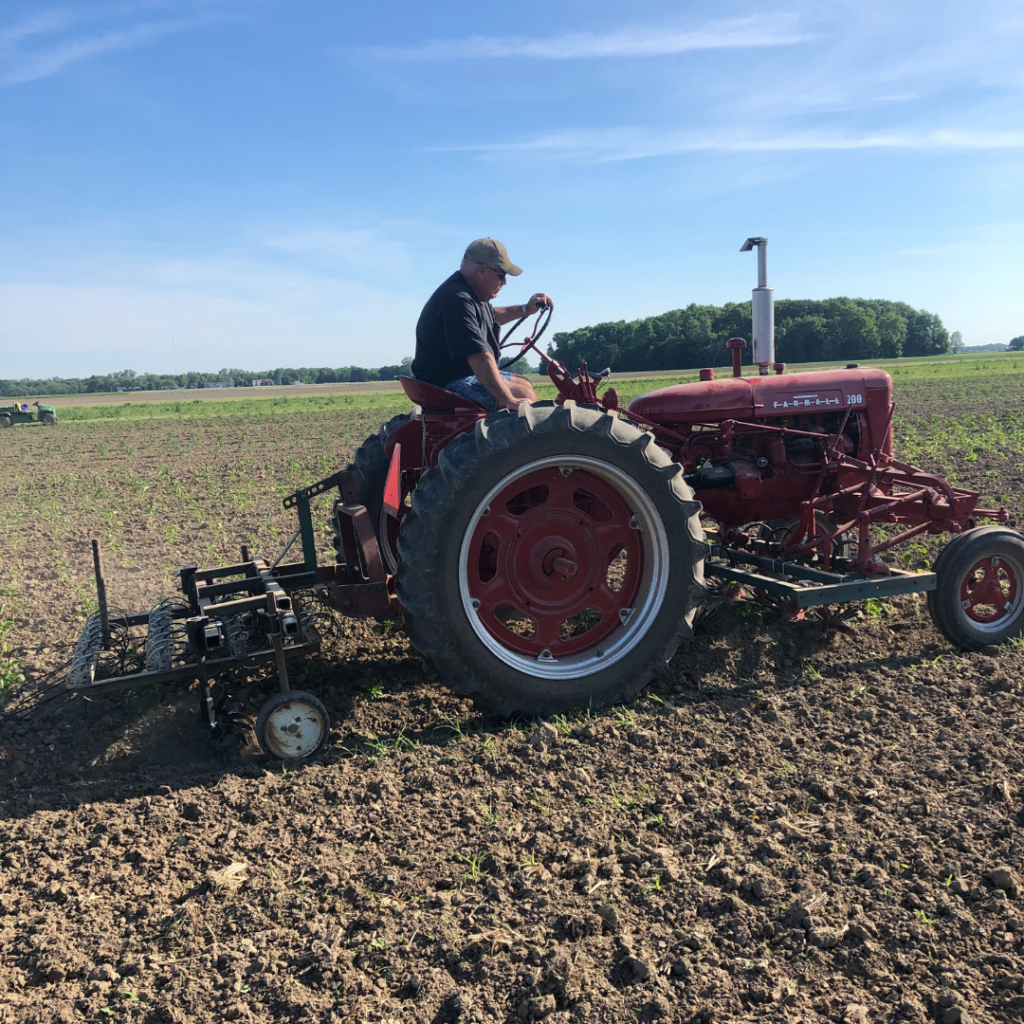
Glen carefully drives over the beds in a perfectly straight line so the cultivators can do their magic below.
Weed City – How Farmers Handle Weeds
Our farm is buried in weeds. After a couple days of heavy rains last week, those weeds popped up fast. So we are playing catch-up this weekend!
Why weeds are bad. Weeds are a part of farm life. They can’t really be avoided. In fact, a small amount of weeds is acceptable. It’s when they overpower the beds, and steal valuable nutrients from the veggie plants that they are detrimental. Sometimes they’ll grow so tall, that they block the sunlight from reaching the veggie plants down below, which stunts their growth. We also want to pull weeds before they flower — spreading their seed to other parts of the field.
So how do we manage weeds? We have weed prevention systems and weed management systems. The first category refers to practices we put in place to keep the weeds from growing in the first place. Weed management refers to all the things we do once the weeds have started growing. Let’s break them down:
Flame weeding: Prevention. Kurt pops a backpack of propane on his back, and turns on the “flame=thrower.” No joke, he aims it at the newly seeded bed just as the weeds begin to sprout, withering the plant. The timing of this is crucial. For example, we know how long it takes for a carrot seed to germinate. So we will flame weed the day before the carrots pop, to make sure we don’t accidentally kill the carrots too.
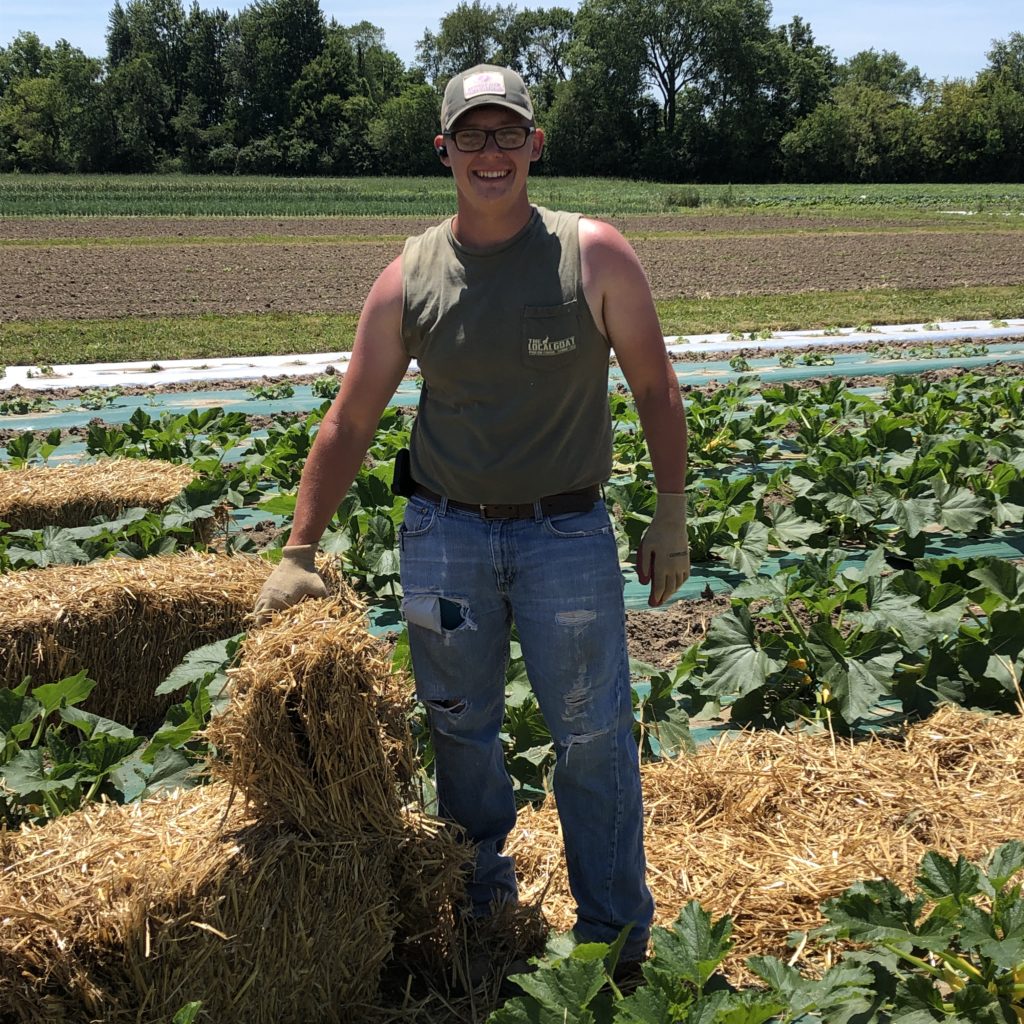
Mulching: Prevention. We place straw mulch on top of the beds to act as a weed deterrant. Robbed of sunlight, the weeds can’t sprout as easily. Plus the straw cools the soil and prevents water loss by evaporation. We also use plastic mulch — the green bed covering. However, weeds often find a way to pop through the holes, and they are very difficult to pull when this occurs.
Tarping: Before we plant a garden bed area, we will sometimes tarp the area for several weeks, robbing the plants of sunshine and killing off the weeds.
Disking: When it comes to thistles, the only way we can attack those is to repeatedly disk the area until the roots have been compromised. This is one of the hardest weeds to manage.
Soil balancing: Prevention. This is a little bit ninja to explain, but all weeds thrive in soil, based on certain soil conditions. So if your sulfur content is too high, you might see more of a certain weed (who likes sulfur) growing like crazy. One way to counteract certain weeds from thriving is to know what it is they like to consume in the soil, do regular soil tests, and then make sure your soil is properly balanced.
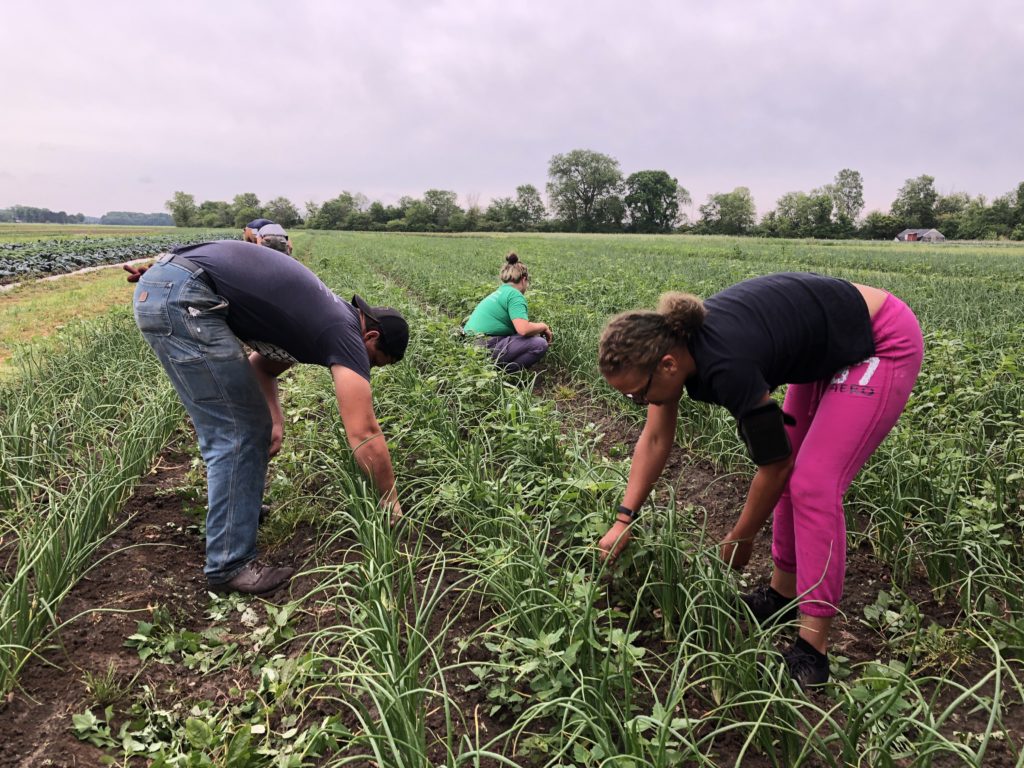 Pulling Weeds by hand: Nothing sexy here! When the weeds get bad, the only way to manage them sometimes is to pull them one by one. This is easier to do when you’ve got a team of people working together. You see the process moving faster, which motivates you.
Pulling Weeds by hand: Nothing sexy here! When the weeds get bad, the only way to manage them sometimes is to pull them one by one. This is easier to do when you’ve got a team of people working together. You see the process moving faster, which motivates you.
Cultivating with a tractor: We use tractors equipped with special under-carriages and finger-weeder attachments that rotate quickly and pull smaller weeds out. Jed and Kurt drive over the beds slowly in a straight line, and make sure that the tines don’t pull out the actual veggie plants too!
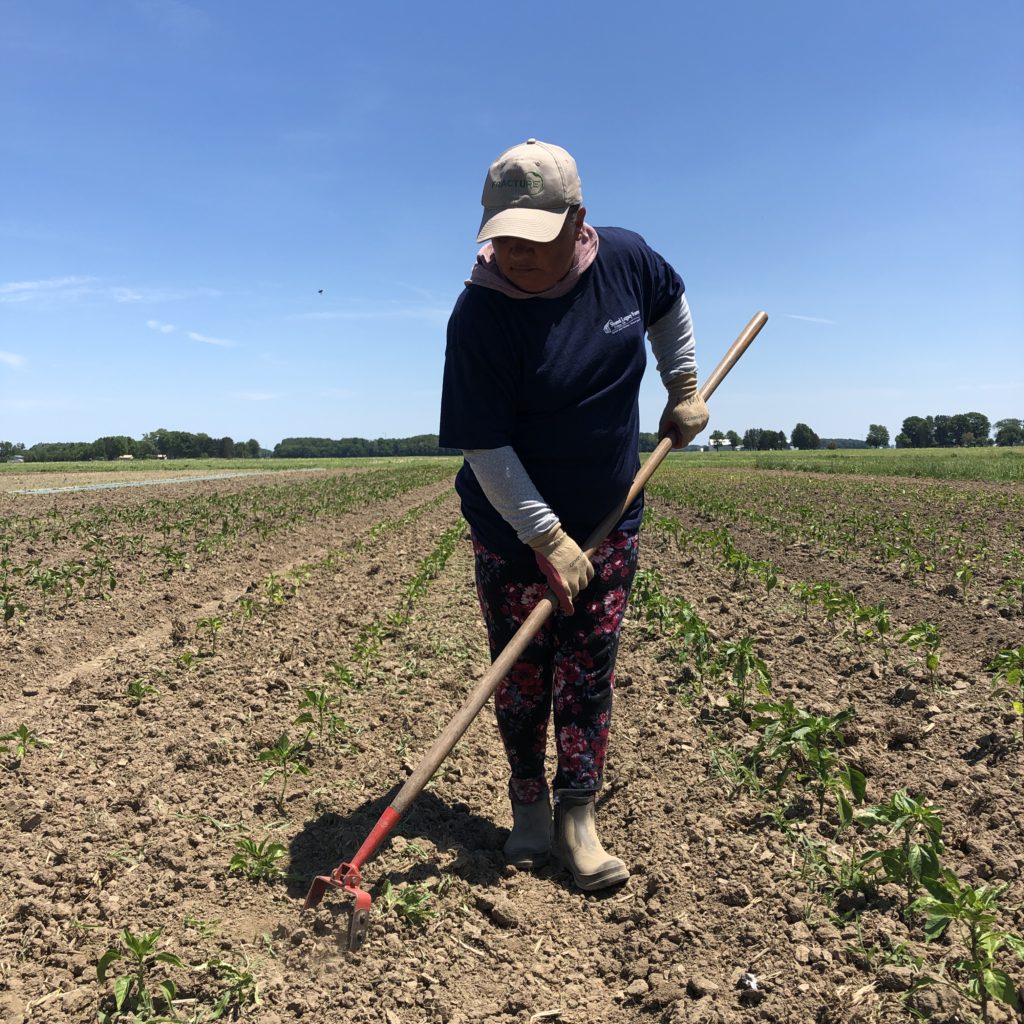
Cultivating with a hoe: The finger weeders can’t get in between the plants though. So for that, we send out the crew with hoes. They scrape between each transplant, and cut the stem from the root.
Cutting the tops off the bed. If the weeds have grown too tall, sometimes I’ll just chop the tops off, and try to get some sunlight to the veggies inside.
Disking up the bed: Sometimes it’s just not worth it to weed. If the cost of time for the labor to pull all the weeds exceeds the profit I would make, then it’s a no go. And I consider the bed a loss and disk it under.
Our most common weeds include: red root, purslane, crab grass, chickweed, thistles, and lambs-quarter.
It’s important to remember that weeds are a natural part of farming. Mother Nature wants to keep her precious soil covered. And those weeds will often give us clues about our soil make-up, since certain weeds thrive when certain elements are high. Who decides what a weed is, anyway? We’ve decided that it’s a weed if we don’t want it growing there! LOL. Organic farmers must work with Mother Nature in creative ways to keep the “wrong” plants from thriving in their fields. Our thanks to everyone who came out this Saturday to help us with the Weed Brigade!
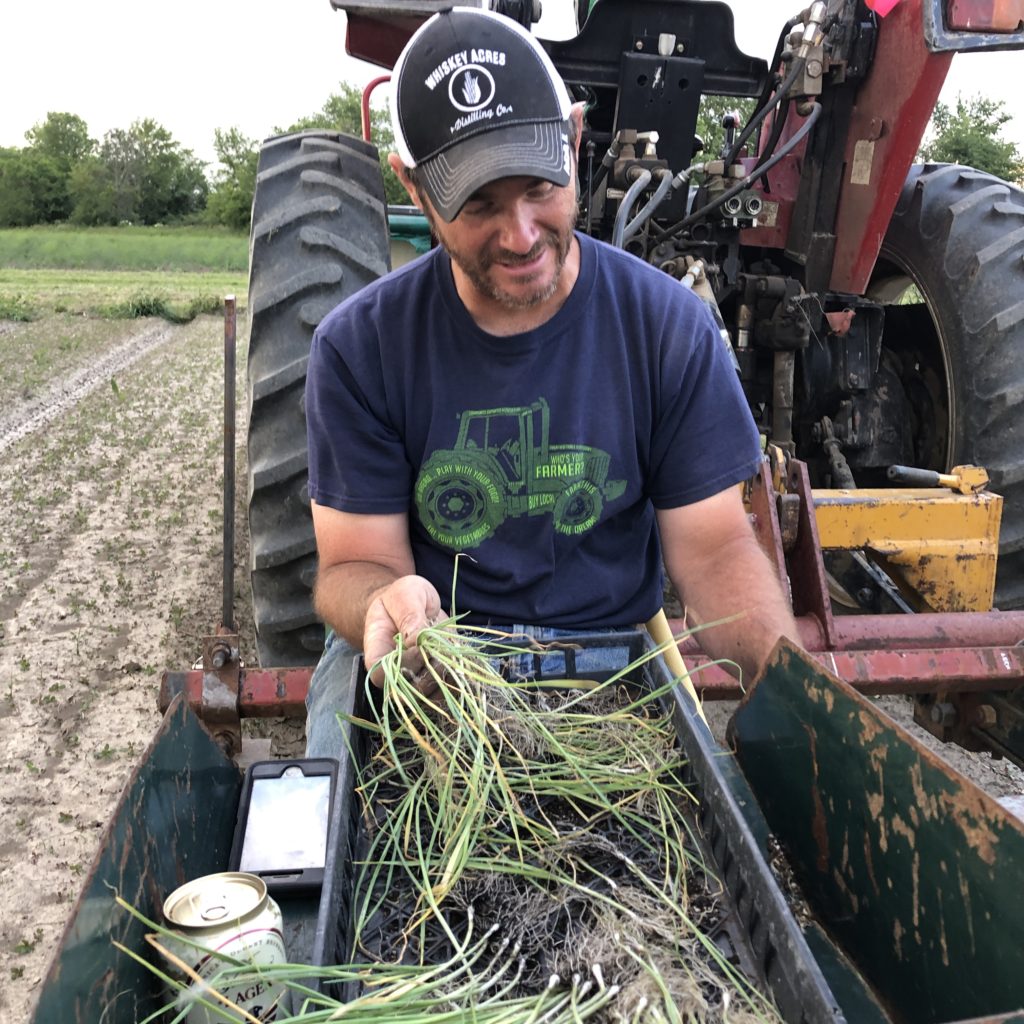
Here I am planting leeks with my son Jed.
FARMER KURT’S FIELD NOTES
Our typical summer schedule is now falling into place. Mondays and Wednesdays are our “CSA harvest days” that run from early morning til 4 PM. Our pack crew shows up at 4 and spends four hours, packing the 200+ bins each session. On Tuesdays and Thursdays, I have a window of time, starting at 3-7:30 PM, where we load the truck and head to the CSA sites. Outside of those commitments, I get to play around with my days and fill in the gaps with other duties each week. Freeing up our Friday and Saturday this year (by not attending the farmer’s market) has been a real gift to me. I feel so much less stressed and can better manage all the plates I have spinning.
This week, for example, I was able to prioritize getting some ground ready for fall crops. We grow cabbage and cauliflower for wholesale accounts, and so I needed to make sure I had that acreage ready for planting. This also involved spreading some gypsum, a naturally-mined product onto the field. When disbursed, there is a bit of a dust cloud, LOL. It adds sulfur into our soil, which is a necessary ingredient for plants to uptake minerals into their roots. I’m always doing soil tests and thinking about how can I better balance the soil to make sure it’s healthy. We follow all the certified organic rules when it comes to adding allowed organic amendments.
Jed, Josiah, and I spend a late night planting leeks this week. We planted them just before dark and just as a huge rainstorm hit. We finished just in time, but we were all soaked by the time we came in! These are happy memories my boys will carry forever. The sweet potatoes were also planted this week by myself and Jed. We use “slips” — which are a transplant that we buy in. They look like stems with just a hint of root forming on one end. I plant them using a finger planter. See the video above where we show you how we do it.
The crew has been weeding a lot. This Saturday was a big push, where we tried to pull 2 giant blocks of weeds from the onions by hand. I also had Jed and Glen working the cultivator finger weeder on the tractor, which cleaned up the weeds from the peppers and tomato beds. Nellie, Keren, and Isaiah were hoeing between the tomatoes. Zac, Shalese, Amanda, and Noah placed straw mulch in between the beds of zucchini and squash to prevent weeds there.
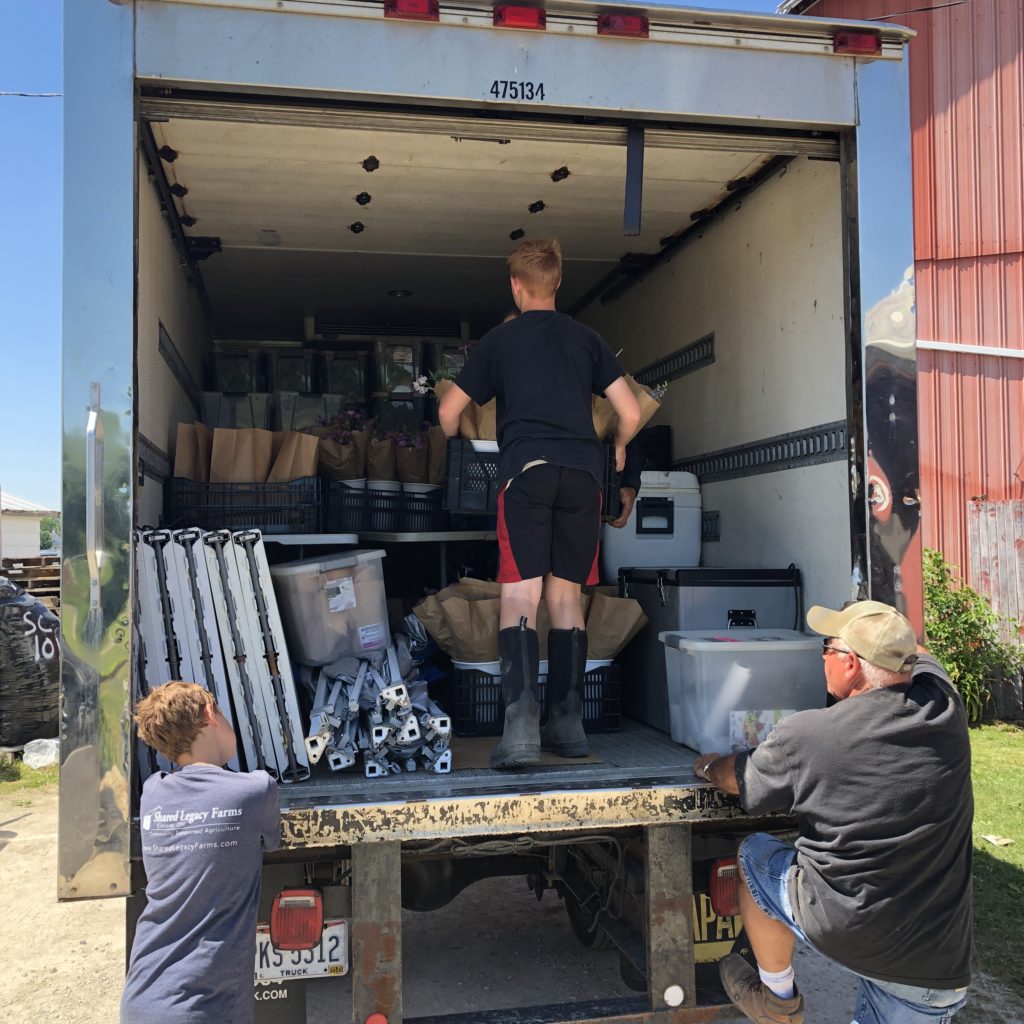
The current box truck was packed to the gills on Thursdays. I don’t know how I’ll fit in corn and fruit!
I’ve begun talks with my CFO, Corinna, about upgrading to a new delivery box truck. The big box truck, aka “the Hino,” is beginning to give me some mechanical issues. Every time we bring it in, it’s $2K for repairs. Right now, the speedometer doesn’t work, and the mechanics didn’t repair it right the first time. I’m reluctant to bring it in again, only to pay for something that doesn’t work again. Corinna is buying me a Garmin, so I can read the speed on that — a creative fix recommended by the truck repairman. The other factor making me lean towards upgrading to a bigger truck, is that we won’t be able to fit all the product in the back soon. Since adding flowers, store orders, and about 30 more shares to our big sites, we’ve got less room than ever to make everything fit. Last week, I barely got it all in, and we didn’t even have fruit shares or the giant corn bins yet. This is a tough financial discussion, since we ALSO have a big capital campaign coming down the pike this fall — to upgrade the staff housing and septic system by next year. We’re having to make tough decisions about priorities.
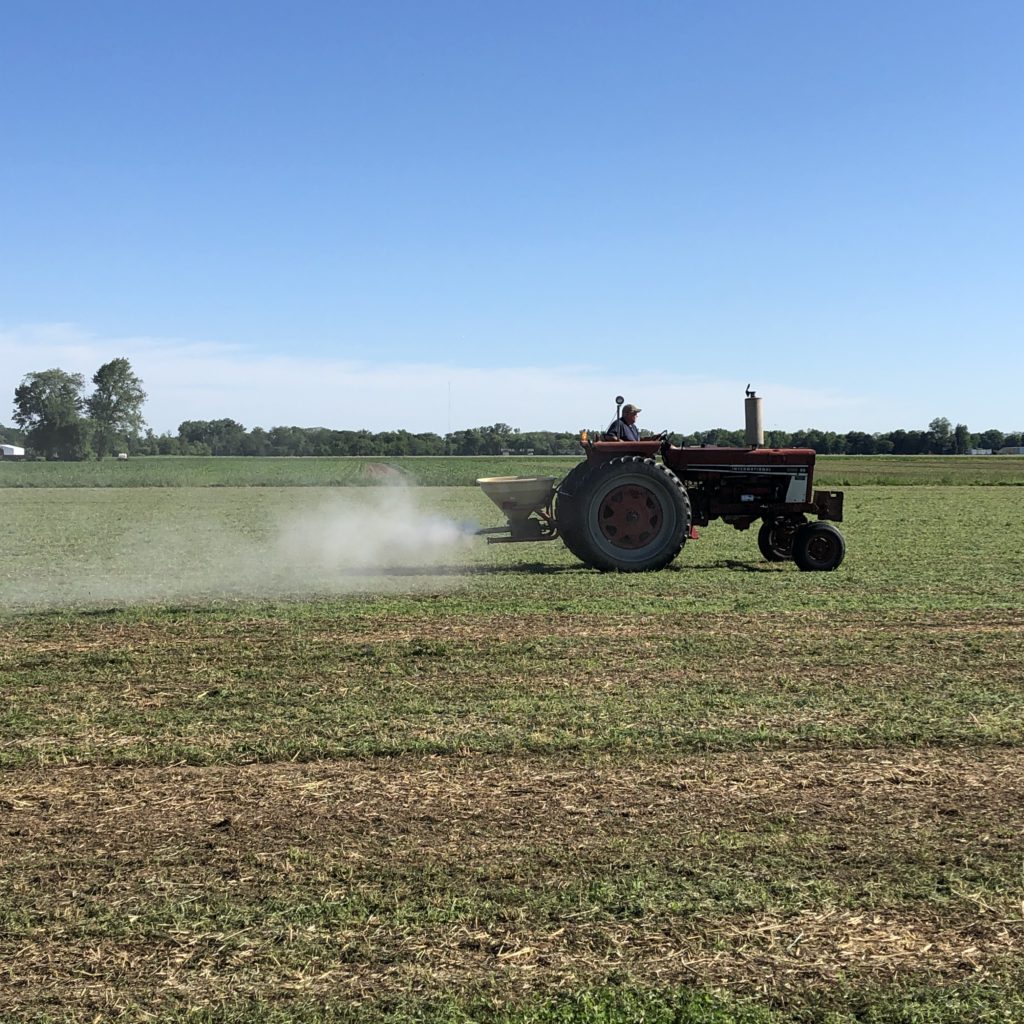
Glen adds gypsum to a new portion of acreage to get ready for planting. This follows organic protocols.
Family time and Father’s Day. Corinna and the boys were able to get away on Friday to go to the Quarry in Gibsonburg and swim. And this Saturday, we’ll be able to attend our cousin Hannah’s wedding party. Sunday is Father’s Day! I’ll be spending that with the boys and Corinna, probably taking a bike ride and eating ice cream somewhere.
And on a sad note, Corinna discovered on Thursday that one of our chest freezer’s extension cords had been accidentally unplugged, and we lost all the freezer beef and pork inside. It was pretty far gone — we actually discovered it by the smell. (That was a serious parenting moment with the boys.) It’s got us thinking about creating a daily system to make sure we are checking our freezer. Could have been worse! At least we didn’t lose the OTHER freezer with our veggies in it too.
~Your Farmer, Kurt

Josiah was driving the tractor with his butt. We called it “butt driving.”
WEEK 3 ANNOUNCEMENTS
- Please return all “Happy Hen” egg cartons that we use to pack the CSA egg share into. We can re-use them.
- This is the first week for fruit shares. If you are “A” week or a weekly fruit share, you will receive a bag of fruit.
- Watch our weekly Live Unboxing video this Tuesday around 8 PM inside the private Facebook group. Cadie Jardin, our CSA coach and dietitian, will show you what’s in the box, share storage tips and ideas for how to use your product. You can find the Facebook group at this link. If you aren’t on Facebook, we download the unboxing video into the digital Academy library (which you all get free access to). Reach out to me if you can’t figure out how to get into the Academy. (www.sharedlegacyfarms.com/academy) — note: you should NOT pay for a membership to the Academy. You get in for free with your membership!
- Want to volunteer for a couple hours, packing the CSA bin? If you’d like to help out one time during a CSA Pack night (Mondays and Wednesdays from 4-8 PM), please email me at sharedlegacyfarms@gmail.com. We require our volunteers to be vaccinated if you want to be mask-less. Otherwise masks must be worn while working.
- Last chance to order T-shirts for this year. Deadline is this Sunday, June 20th. It’s time to order your 2021 SLFarms Tshirt! This year we are offering a classic t-shirt (the soft kind like last year), long-sleeve tshirt, hoodie and raglan sweatshirt. Lots of sizes (youth sizes too), and colors! Deadline to order is next Sunday, June 20th. The tshirts are being ordered directly from our favorite local Tshirt printer, Ortinau Art in Pemberville. Go to https://store.ortinauart.com/shared_legacy_farms/ The link will take you to the webstore where you can order, pay, and they will even ship the product right to your door. (Reasonable postage: $4 for a basic tshirt).
- You can order additional items from the Shared Legacy Farms online store. Fresh dill, romaine lettuce, chef’s delight, carrots, garlic scapes, red and white scallions, rye flour, maple syrup, honey, and black currants. Our store link is super easy to remember: www.sharedlegacyfarms.com/store. We usually reload and open the store inventory on Saturdays, around 6 PM. Just be sure to select the right pickup site that coincides with your pickup location. If the pickup option is greyed out or not available, it means you missed the window to order. You need to place your order 2 days before your site. We harvest the product on Monday and Wednesday mornings — early.
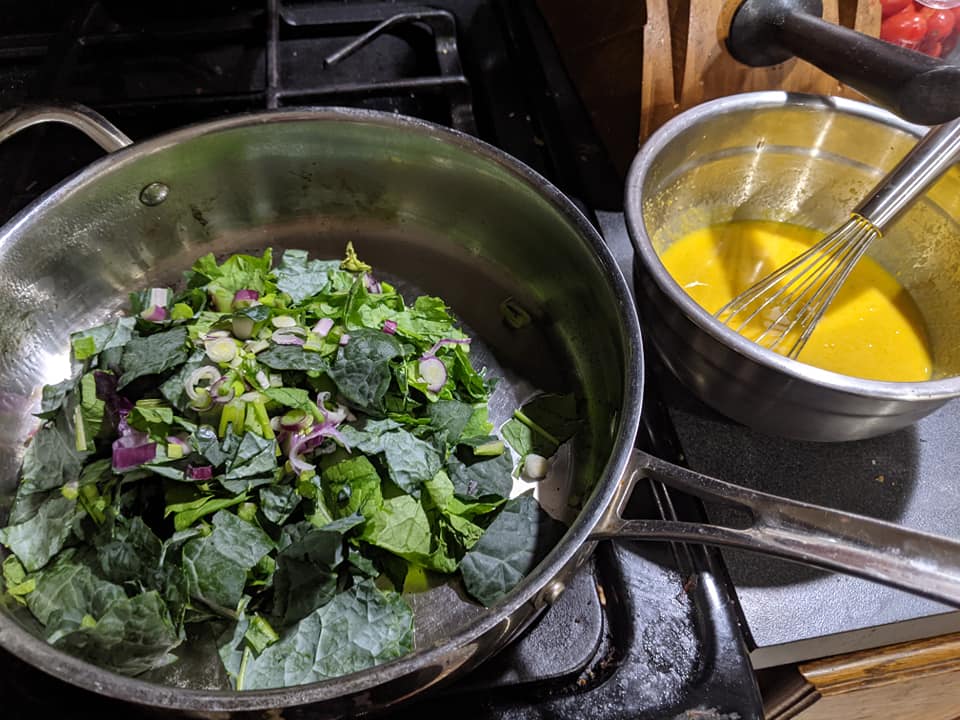
Sarah Mainardi used her turnip greens and kale in an omelette last week!
WEEK 3 CSA RECIPES
Members: You can download these recipes as a PDF here. These recipes are designed to inspire you to use your box this week! Please check inside our private Facebook group to find your fellow members sharing ideas for what to make with their box! Share a photo and you might be featured in next week’s newsletter!
- Garlic Scape Dressing
- Grilled Garlic Scapes
- Zucchini Noodles with Garlic Scape Pesto, Peas & Mint
- Kohlrabi Slaw
- Roasted Potato and Kohlrabi Salad
- Herbed Summer Squash Salad
- Microwave Kale Chips
- Kale, Potato and Carrot Curry
- Fresh Red Currant Yogurt Cakes
- Red Currant Clafoutis
- Fresh Cherry Salsa
- Dark Chocolate Cherry Overnight Oats

